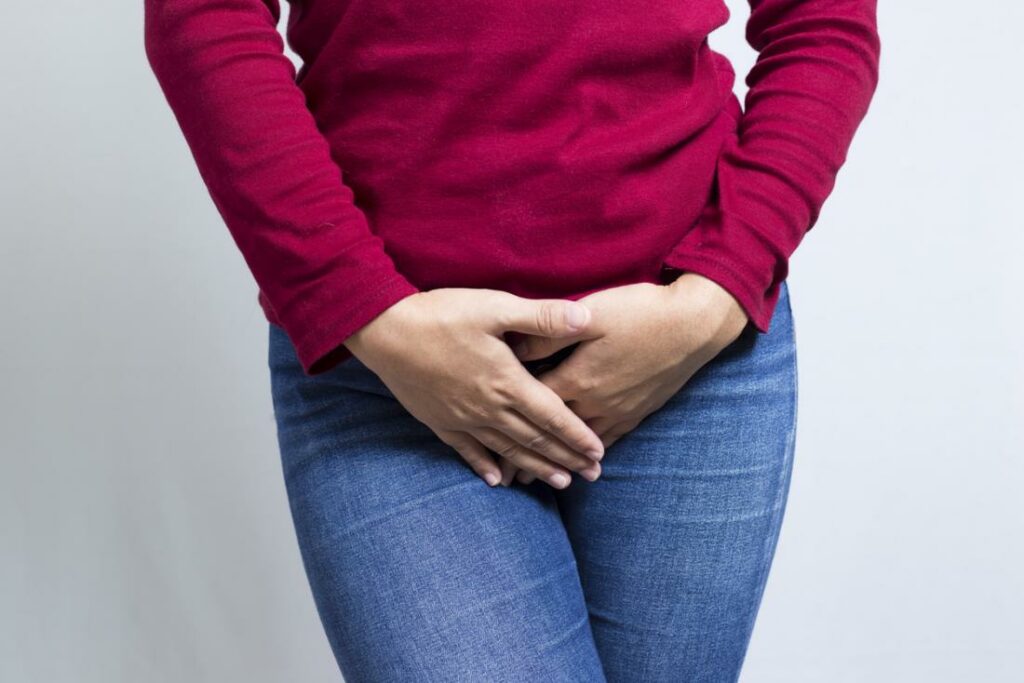Menopause is a natural phase in a woman’s life that marks the end of her reproductive years. While it brings about various changes in the body, one aspect that often goes unaddressed is the impact on sexual health. Dyspareunia, or painful intercourse, is a common concern among menopausal women, affecting both their physical and emotional well-being. In this blog, we will explore the causes of dyspareunia during menopause and delve into the various treatment options available to alleviate this discomfort.
Contents
What is “Dyspareunia in Menopause”?
Dyspareunia in menopause refers to the experience of pain or discomfort during sexual intercourse in women who are going through or have completed menopause. Menopause is a natural biological process that marks the end of a woman’s reproductive years, usually occurring in the late 40s or early 50s. During menopause, the ovaries gradually reduce the production of hormones, particularly estrogen and progesterone.
The decline in estrogen levels has various effects on the body, and one of the consequences can be changes in the vaginal and pelvic tissues. Dyspareunia, or painful intercourse, can arise due to these changes. Several factors contribute to dyspareunia during menopause:
- Vaginal Atrophy: The decrease in estrogen levels can lead to a condition known as vaginal atrophy. This involves the thinning, drying, and inflammation of the vaginal walls. As a result, the vaginal tissues become less elastic and more susceptible to irritation and tearing during sexual activity.
- Lack of Lubrication: Reduced estrogen levels also affect the production of natural lubrication in the vagina. Insufficient lubrication can result in increased friction during intercourse, leading to discomfort and pain.
- Pelvic Floor Changes: Menopause can contribute to changes in the pelvic floor muscles, which support the pelvic organs, including the bladder, uterus, and rectum. Weakening of these muscles can lead to pain during sexual activity.
- Psychological Factors: The hormonal changes and physical symptoms associated with menopause can contribute to psychological factors such as anxiety, stress, or decreased libido. These factors may further exacerbate pain during intercourse.
It’s essential to note that the severity of dyspareunia varies among women, and not every menopausal woman will experience this symptom. Additionally, some women may not experience dyspareunia until several years after entering menopause.
Different Treatment Methods for Dyspareunia in Menopause
Management and treatment of dyspareunia during menopause often involve addressing the underlying causes. Here are some treatment methods:
Pelvic Floor Physical Therapy
Pelvic Floor Physical Therapy is a non-invasive and specialized form of physical therapy designed to address dyspareunia by targeting the muscles and tissues of the pelvic floor. During menopause, hormonal changes can contribute to the weakening of pelvic floor muscles, leading to pain during sexual activity.
1. Pelvic Floor Exercises: Physical therapists work with individuals to develop a personalized exercise regimen aimed at strengthening the pelvic floor muscles. These exercises, such as Kegels, help improve muscle tone and endurance, reducing pain and discomfort during intercourse.
2. Biofeedback: Biofeedback is a technique used in pelvic floor physical therapy to help individuals gain awareness and control over their pelvic muscles. Sensors are used to provide real-time feedback on muscle activity, assisting patients in learning how to relax and contract these muscles appropriately.
3. Electrical Stimulation: In some cases, electrical stimulation may be incorporated into pelvic floor physical therapy. This involves the use of low-voltage electric currents to stimulate and strengthen the pelvic floor muscles.
4. Manual Techniques: Physical therapists may use hands-on techniques to address muscle tension and trigger points in the pelvic floor. This may involve internal or external manipulation to release muscle tightness and improve flexibility.
Pelvic floor physical therapy is beneficial not only for addressing dyspareunia but also for improving overall pelvic health. It is particularly valuable for women who may experience pelvic floor dysfunction, which can contribute to pain and discomfort during sexual intercourse.
Counseling and Sex Therapy

Psychological factors, such as anxiety, stress, and fear of pain, can significantly contribute to dyspareunia during menopause. Counseling and sex therapy provide a holistic approach to addressing both the physical and emotional aspects of sexual discomfort.
1. Addressing Emotional Factors: Qualified therapists can help women explore and manage emotional factors contributing to dyspareunia. This may involve discussing personal feelings, body image concerns, or relationship issues that can impact sexual well-being.
2. Cognitive-Behavioral Therapy (CBT): CBT is a therapeutic approach that focuses on identifying and changing negative thought patterns and behaviors. For women experiencing dyspareunia, CBT can help reshape thoughts related to pain and improve coping strategies.
3. Sensate Focus Therapy: Sensate focus is a type of sex therapy that involves gradual and non-demanding sensual touch. This approach helps couples reconnect emotionally and physically, fostering a positive and relaxed environment for sexual intimacy.
4. Communication Skills: Sex therapy often includes communication skills training to facilitate open and honest discussions between partners. Improved communication can lead to a better understanding of each other’s needs and concerns.
Counseling and sex therapy provide valuable tools for managing dyspareunia, particularly when psychological factors contribute to the condition. A multidisciplinary approach that combines physical and emotional interventions can yield comprehensive and lasting results.
Lifestyle Modifications

Making certain lifestyle modifications can contribute to overall well-being and positively impact sexual health during menopause.
1. Healthy Diet: A well-balanced diet rich in nutrients supports overall health, including the health of the reproductive system. Adequate hydration is also essential for maintaining mucous membrane hydration, including the vaginal tissues.
2. Regular Exercise: Engaging in regular physical activity promotes blood circulation, which is beneficial for maintaining vaginal health. Exercise also helps manage stress and contributes to a positive mood.
3. Stress Management: Stress and anxiety can exacerbate dyspareunia. Practicing stress management techniques such as deep breathing, meditation, or yoga can help alleviate tension and improve overall well-being.
4. Adequate Sleep: Quality sleep is crucial for hormonal balance and overall health. Ensuring an adequate amount of sleep each night can positively influence sexual function and reduce fatigue.
5. Smoking Cessation: Smoking has been linked to decreased blood flow and hormonal imbalances, which can impact sexual health. Quitting smoking can have positive effects on overall vascular and hormonal well-being.
6. Regular Sexual Activity: Engaging in regular sexual activity, even without the goal of intercourse, helps maintain vaginal elasticity and lubrication. It also promotes a positive sexual self-image.
It’s crucial for women experiencing dyspareunia during menopause to consult with their healthcare provider. A thorough evaluation can help identify the specific factors contributing to the pain, and an individualized treatment plan can be developed to improve sexual comfort and overall quality of life.
Sources To Get Treatment for Dyspareunia in Menopause
![]()
Several reputable online platforms provide information and resources for women seeking treatment for dyspareunia during menopause. The following sources are valuable for understanding the condition and connecting with healthcare professionals:
- HerMantra: HerMantra’s website offers comprehensive information on dyspareunia, menopause, and available treatment options. Users can find expert insights, self-care tips, and contact information for further assistance.
- WebMD: WebMD provides an extensive range of articles, expert advice, and user-friendly resources on women’s health. Their content covers dyspareunia causes, symptoms, and various treatment approaches, helping individuals make informed decisions about their health.
- American College of Obstetricians and Gynecologists: ACOG’s website is a reliable source for evidence-based information on women’s health. It offers patient resources, educational materials, and a “Find an Ob-Gyn” tool to locate qualified healthcare professionals specializing in menopausal concerns.
- Healthline: Healthline’s women’s health section provides accessible and well-researched articles on dyspareunia, menopause, and related topics. The platform also includes a directory for finding local healthcare providers.
- Telehealth Platforms: Platforms like Teladoc, Amwell, and Doctor On Demand offer telehealth services, allowing women to consult with healthcare professionals virtually. These platforms facilitate remote access to specialists who can guide dyspareunia management.
Conclusion
In conclusion, managing dyspareunia during menopause requires a multifaceted approach that addresses both physical and emotional factors. Treatment options such as Hormone Replacement Therapy, Local Estrogen Therapy, and Vaginal Moisturizers offer targeted solutions, while Pelvic Floor Physical Therapy and Counseling provide holistic support. Lifestyle modifications play a crucial role in enhancing overall well-being. By tailoring treatment plans to individual needs and fostering open communication with healthcare providers, women can navigate this aspect of menopause with greater comfort and improved quality of life.
If you are facing menopause-related issues, menopause treatment at HerMantra can help. Book your free trial online menopause treatment session now.



